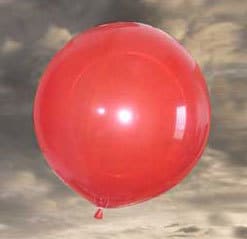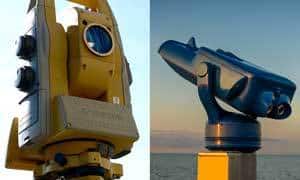Defining Pilot Balloons – What They Are And Their Use In Meteorology

When thinking of meteorological equipment, one usually imagines sophisticated, hi-tech devices. Surprisingly, simple helium-filled balloons, better known as pilot balloons, are also widely used.
In meteorology, a pilot balloon is defined as a small helium-filled balloon used to measure the height of a cloud base or to monitor upper-atmospheric winds. It is produced in red, black, or white to increase visibility and surveyed from the ground with the assistance of a theodolite or binoculars.
As the last sentence alluded to, this type of balloon is used for meteorological observations. Unlike the standard high-altitude weather balloons you may have seen or read about, this type of balloon has a more limited but specific purpose.
It may all sound vague and not very helpful in explaining what it is and what actual purpose it serves in any meteorological service. And this is where this post comes in.
This article clearly explains what a ceiling balloon is, what its characteristics are, as well as how it works in more detail.
What Is A Ceiling Balloon?
The introduction already provided a broad but still vague definition of this meteorological piece of equipment. Before looking at it in more detail, one first needs to gain a clear and concise understanding of precisely what a ceiling balloon is:
Ceiling Balloon Definition

In meteorology, a pilot or ceiling balloon is a small helium-filled balloon used to measure the height of a cloud base or monitor upper atmospheric winds. It is manufactured in red, black, or white to increase visibility and surveyed from the ground with the assistance of a theodolite or binoculars.
A ceiling balloon is also known as a pilot balloon or pibal, which may sound more professional and on-point than the "confusing" ceiling balloon description.
There is, however, a logical reason for the term "ceiling balloon." We know a ceiling balloon measures the height of a cloud base. For all practical purposes, a "cloud base" is also known as the "cloud ceiling" (bar a few small technicalities). Hence the term "ceiling balloon."
Ceiling balloons should not be confused with the more familiar and larger weather balloons. The latter can be up to 5 meters (16 feet) in diameter, carry a full array of weather sensors (called a radiosonde), and can reach altitudes of 37 km (23 miles).
(You can read all about these more conventional weather balloons in this article.)
Pilot balloons (or pibals) are produced in red, black, and white to increase their visibility when tracked from the ground. When fully inflated, the balloon has a diameter of approximately 40 cm (15.7 inches).
Unlike other meteorological devices, ceiling balloons can only be operated during daylight since they have to be physically observed from the ground to take accurate measurements.
How A Ceiling Balloon Works
A ceiling balloon works on a simple principle to accurately measure the height of a cloud base (or cloud ceiling) or measure upper atmospheric winds. It makes use of a predetermined rate of ascent and visual tracking to make precise observations.
This process, by which it takes place, can be explained in a few simple steps:
The first and most important part of the process is making sure the balloon ascends at the predetermined speed of 140 meters per minute (460 feet per minute). This is done by filling the balloon with helium while being attached to a weighted object. The weighted object has a mass calculated to cause it to start lifting once the correct amount of gas has filled the balloon. Once it begins to lift, the balloon will rise at the predetermined ascent rate, and the gas is sealed inside. The filled balloon can now be released from a set surface. Once released, the observer will carefully monitor its ascent by visually tracking it while using a timer to calculate the height of the cloud base. Once the balloon enters the cloud and disappears from view, the timer is stopped, and the height of the cloud base is calculated by using the total time of ascent. When calculating visibility, the balloon is also observed until it finally disappears from view. In this case, it is also carefully noted when and how far the balloon remains visible after entering a cloud or in misty conditions. The balloon's ascent is tracked with the naked eye or with visual aids like a simple pair of binoculars. In some instances, a more sophisticated device called a theodolite assists in measuring specific angles to help with observing upper atmospheric winds.

Visual Aids: Theodolite and binoculars
It may seem like a very simplistic and outdated process, but when done correctly, it provides an accurate measurement of a cloud base. It is also able to make a detailed and useful assessment of visibility in misty conditions.
Ceiling Balloon Key Facts
Although most of these were already mentioned throughout this post, the following list has been compiled to highlight the key facts you need to know about a ceiling balloon:
Conclusion
It may not be the most glamorous or sophisticated meteorological device, but the humble ceiling balloon does what it is meant to do very well. If correctly prepared and inflated, it can provide consistently accurate readings.
It does have some limitations and drawbacks, as mentioned in the previous section, but it is still a valuable and easy-to-use tool in the arsenal of any meteorological service.
This article explained what a ceiling balloon is, what its characteristics are, as well as how it works in detail.
Never miss out again when another interesting and helpful article is released and stay updated, while also receiving helpful tips & information by simply following this link .
Until next time, keep your eye on the weather!
